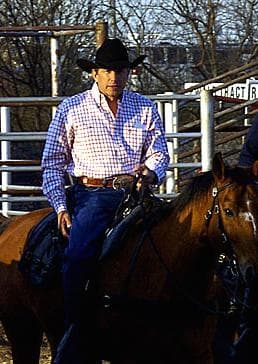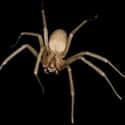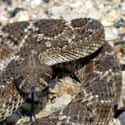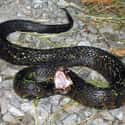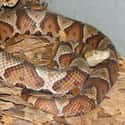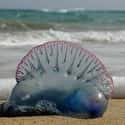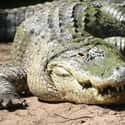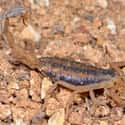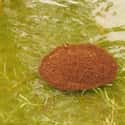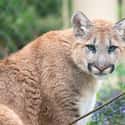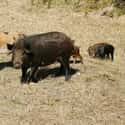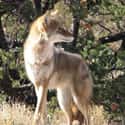-
(#1) Brown recluse spider
- Loxosceles reclusa
Nesting and making its webs across the shed rafters, underneath the cardboard boxes, and between scattered clothes is the brown recluse spider. The spider is often nocturnal and shy, but as such can establish and thrive in manmade areas by "hitchhiking," stowing away in darkplaces including trashcans or boxes then infesting when brought indoors. Unlike other spiders, the brown recluse is distinctive for its six eyes and violin-shaped marking.
The brown recluse spider has an incredibly venomous bite. Their bites affect people in different ways but in rare instances their bites can be fatal. In the worst circumstances, a brown recluse spider bite could create a "volcano lesion" and turn gangrenous or develop necrosis. Other symptoms of a bite may include itching, chills, fever, nausea, sweating and a general feeling of discomfort or sickness.
-
(#2) Crotalus atrox
- Crotalus atrox
The western diamondback rattlesnake, AKA the Texas diamondback, is a venomous pit viper that delivers a aggressive and dangerous strike. They are common in the American Southwest and Northern Mexico and can be distinguished from other rattlesnakes by the black and white bands above the snakes rattle.
The western diamondback rattlesnake accounts for more human bites than any other rattlesnake in the American Southwest, and their bites are packed with a slew of serious side-effects. If bitten by a a western diamondback, nausea, dizziness, and convulsions are the least of a person's worries. These rattlesnakes have hemotoxic venom that can cause immediate blood clotting and coagulation. They use their venom to completely immobilize their prey, which are mostly small mammals, reptiles, and birds. When a western diamondback bites a human, however, their venom can causes extensive tissue damage and swelling but can also be fatal.
-
(#3) Agkistrodon piscivorus leucostoma
- Agkistrodon piscivorus leucostoma
Western cottonmouth snakes may have a shy temperament but are potentially one of the most deadly animals found in Texas. Also known as water moccasins, the western cottonmouth can potentially be found in any aquatic environment in Northern Central Texas including pools, lakes, rivers, or streams. They can be distinguished by their flat, broad head, their thick body decorated with dark and irregular cross bands, and their slender tail.
When confronted, western cottonmouth snakes would rather run away or completely freeze to blend into its surrounding and will open its mouth, revealing it's namesake, before striking. If it strikes, however, the venom it injects can be potentially deadly. The western cottonmouth's venom is a hemotoxin that prevents the blood from clotting and could cause hemorrhaging in the circulatory system, temporary or permanent tissue damage, and possibly the loss of bodily extremeties depending on where the bite is located.
-
(#4) A Kissing Bug Can Leave You Prone To Chagas Disease
Seemingly small and harmless, the kissing bug is a vector for the deadly Chagas disease. There are 11 different species of kissing bug found throughout the entire Southern United States, but are found in highest diversity and density in the American Southwest, including Texas, New Mexico, and Arizona.
The true kiss of this insect is its vampiric bite, which it delivers when it sucks your blood or that of your animals. After it is done feeding, it leaves behind its fecal matter. The feces contains a tropical parasite that causes Chagas disease, and if rubbed into the bite wound, infection can occur.
While some people can go their entire lives without showing symptoms of Chagas disease, around 20%-30% of infected people will go on to develop debilitating and life threatening medical problems such as heart abnormalities and dilated digestive organs.
-
(#5) Agkistrodon contortrix
- Agkistrodon contortrix
Texas is home to three species of copperhead snakes: the southern copperhead, Trans-Pecos copperhead, and the broad-banded copperhead. All of which can be identified by their light brown body and reddish-brown crossbands.
The copperhead snake is a very timid creature. Rather than put up a fight, it prefers to flee or attempt to blend in with its environment to remain out of harm's way. It can, and will, strike at a threat if intimidated. On average, copperhead snake bites account for more human bites per year than any other snake. While those bites rarely result in death, the venom can cause tissue damage, mild nausea, and can be incredibly painful
-
(#6) Portuguese Man o' War
- Physalia physalis
The Portuguese man o' war might look deceptively like a jellyfish, but it's far from it. This creature is made up of a mass of individual organisms, making it a "siphonophore." The long, draping strands of organisms that trail down 6 feet from the Portuguese man o' war's buoyant bubble form tentacles that are packed with venom designed to stun and kill prey like small fish. On rare occasions, it can also be deadly for an unfortunate human.
These carnivorous siphonphores have been known to wash up on Texas beaches between spring to late summer, but they should still be avoided even if they're dead. Alive or not, their stings cause very painful "burning rash streaks."
-
(#7) Alligator
- Alligator
American alligators sit at the top of the food chain in their freshwater territories. They can be found throughout the Southern United States including the rivers and wetlands of Texas. On average, a male gator grows up to 11 feet, and in rare cases, can weigh upwards of a thousand pounds. These aquatic reptiles have large armored body, a flat muscular tail, and a broad head with rounded nostrils facing upwards to allow the animal to breath while still mostly submerged underwater.
American alligators are a force to be reckoned with, and can be incredibly dangerous. Despite their size, alligators are well-camouflaged and incredibly quick, making them an apex predator. On land these reptiles can run up to 11 mph for short bursts, but while in water they can swim at 20 mph for extended periods of time. When they are waiting and watching their prey they look similar to logs until they get close enough to strike with jaws that can snap tortoise shells.
-
(#8) Scorpion
- Scorpiones
The striped bark scorpion may be small and unassuming, but that's what makes this arthropod so dangerous. It is the most common scorpion in Texas, and it can be found throughout the state, living in dark crevices in vegetation, sheds, barns, and household objects. Thousands of people are stung each year and though their venom isn't deadly, their neurotoxins can cause swelling, itching, numbness and pain, which may last anywhere between hours to days.
-
(#9) Flood-Rafting Fire Ants Are Extremely Adaptable And Dangerous
Fire ants may not be native to Texas, but they have become increasingly pervasive since their introduction to the state in the 1950s and have exterminated other native breeds of ant due to their aggressive behavior. Though they may not be intimidating individually, as a colony they can be harmful to plants, animals, and humans alike. When threatened fire ants are aggressive and will act in mass to protect their colony. They can bite and sting, which can be painful and leave white pustules, but when one ant stings, it triggers others to do the same. Despite being able to observe their behavior, it isn't clear how their response is triggered and communicated.
Not only are these fire ants highly aggressive and territorial, they are incredibly adaptable. These ants have waxy bodies, and when clustered together they can create a "raft" so the colony can continue to survive. Fire ants rafts were rampant during Hurricane Harvey, and citizens were able to capture videos of these little critters lumped together and floating along.
-
(#10) Cougar
- Puma concolor
The cougar (AKA mountain lion) is a large cat species found throughout North America, including many regions of Texas. Though small compared to other large cat species around the world, weighing in between 65 and 150 lbs depending on gender and geographic location, it's still an incredible predator. Often solitary except for during the three to five days a year when they're breeding, the cougar is an incredibly stealthy hunter, electing to stalk and ambush rather than face their prey head on.
Encounters with mountain lions have increased as people have began encroaching on their natural habitat. Cougars have been known to prey on domestic livestock, pets, and human beings, usually selecting smaller targets who are less able to defend themselves.
-
(#11) Wild Hogs Roam Free, Spreading Diseases And Causing Damage To Property
Wild hogs are free-roaming, feral pigs that wreak havoc across the US, causing $400 million in damages in Texas alone. The old world species was imported by Spanish explorers around 1542 and has been running amok in Texas ever since. They are known as "opportunistic omnivores" and have been observed to eat pretty much anything they can find, including whole fields of sorghum, rice, and other crops as well as wildlife like deer, quails, and sea turtle eggs. Their eating habits have caused dramatic soil erosion and disrupted natural vegetation growth.
Not only are they a nuisance and potentially disastorous, they are also a vector for some potentially fatal diseases like swine brucellosis, a disease that inflames the respiratory system and can be transmitted to both domesticated pigs and humans.
-
(#12) Coyote
- Canis latrans
Coyotes pose a deadly threat to pets and livestock, but a human death from a coyote attack is very unlikely. Urbanization is causing coyotes to lose their fear of humans, and they've been noted to act with aggression towards humans, stalking and chasing bicyclists, animals, and small children. They're attracted to anything that smells like food, so pet food, garbage, or outdoor animal feeders for squirrels or birds are an open buffet.
Coyotes are not a friendly encounter for anyone who owns a pet or livestock out on the open range. They are the most abundant livestock predator and will make a meal out of dogs, calves, sheep, chickens, and anything that's small enough to kill with a crushing bite to the skull.
-
(#13) Raccoon
- Procyon
North America is very familiar with the bandit-faced raccoon, which runs amok across the entire country, but is an exceptionally pesky pest in the state of Texas. The common raccoon is a wild animal that causes significant property damage. Though they are not predators attacking living creatures for their next meal, they are highly aggressive when cornered. They can get into bloody scraps with livestock and pets as they search for food in the late hours of the night.
Raccoons are carriers of diseases like rabies and raccoon roundworm, which are transmitted through direct contact with both the animal and their fecal matter.
New Random Displays Display All By Ranking
About This Tool
Texas has the most abundant biodiversity in America, but the increase in population and continuous development makes the ecosystem in danger. Texas is a paradise for some of the most deadly animals and insects in the United States, where a mild climate and diverse vegetation provide the best growth environment for these fatal animals.
A variety of species of bugs, reptiles, and mammals inhabit the vast lone star state, and many of them have the potential to kill people. While finding a comfortable and perfect travel destination, take appropriate precautions or learn about some common deadly animals or insects. The random tool introduced 13 deadliest Texas animals that people could be careful.
Our data comes from Ranker, If you want to participate in the ranking of items displayed on this page, please click here.


